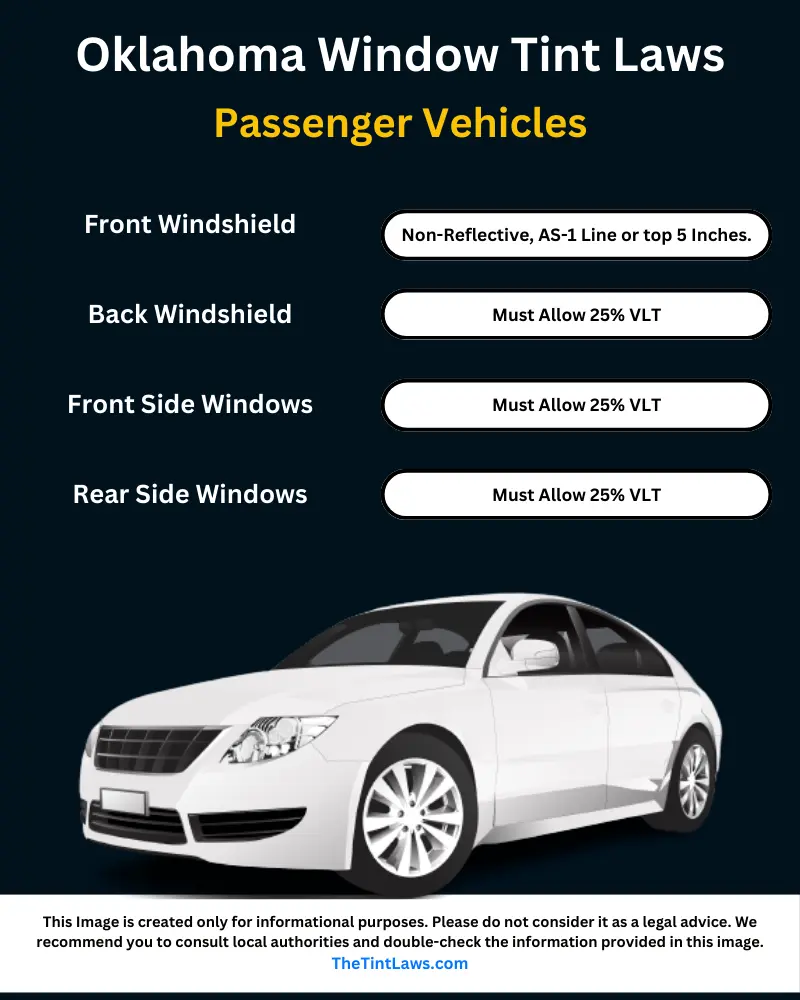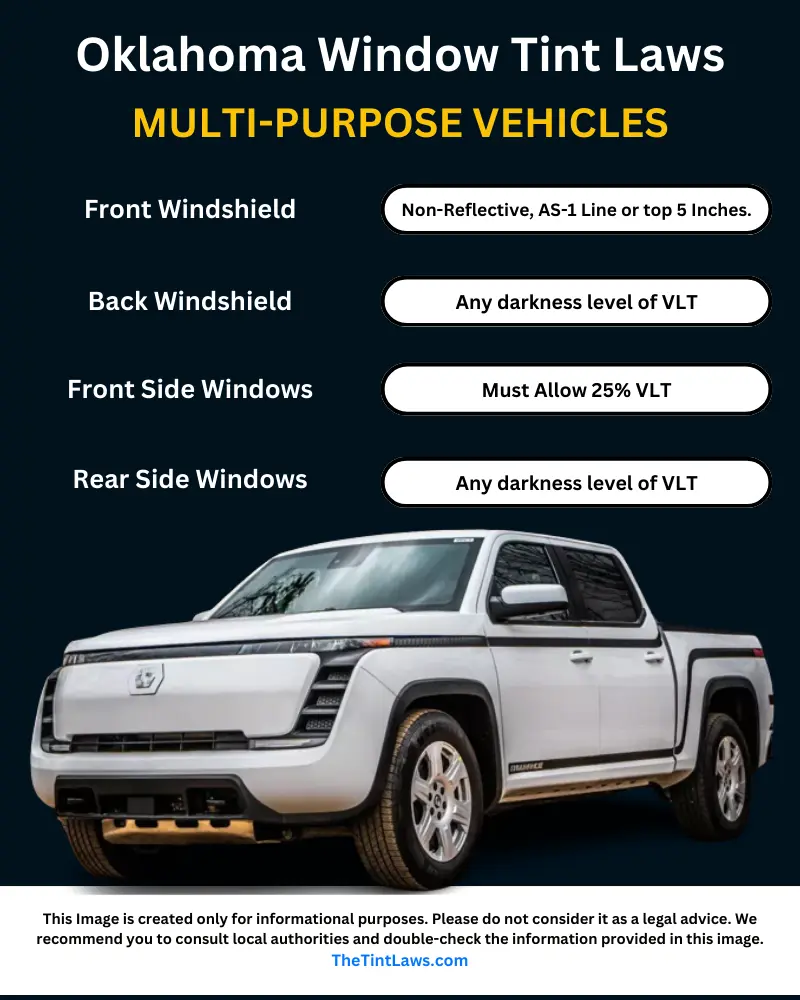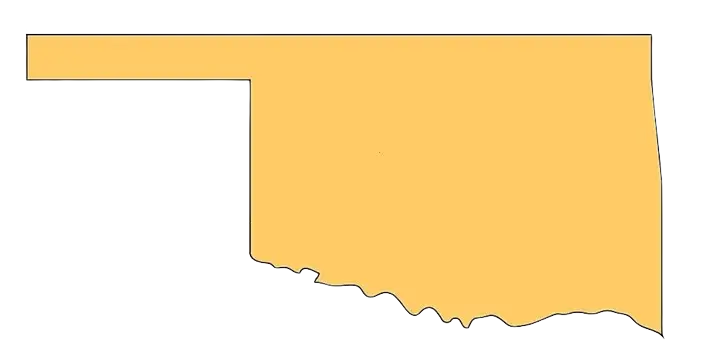Keeping your car cool and your belongings protected with window tint is a popular choice for Oklahoma drivers. But before you get your windows tinted, understanding the Oklahoma tint laws is crucial to avoid fines and ensure safe driving.
This guide will break down everything you need to know about legal tint in Oklahoma.
Window tint laws in Oklahoma were enacted in 2005.
The darkest legal window tint in Oklahoma is 25% of VLT for all windows except the front windshield according to the window tint laws in Oklahoma State.
How tint percentage is measured by the Oklahoma Tint Laws?
The legal tint of darkness is measured by Visible Light Transmission (VLT), which indicates the percentage of light that passes through the film. Here’s a breakdown of the legal VLT limits for different types of vehicles.
Legal tint darkness for sedans:
- Windshield: Only non-reflective tint is allowed above the manufacturer’s AS-1 line or top 5 Inches.
- Front side windows: More than 25% of VLT should be allowed.
- Backside windows: More than 25% of VLT should be allowed.
- Rear window: More than 25% of VLT should be allowed.

Legal tint darkness for SUV and Van:
- Windshield: Only non-reflective tint is allowed above the manufacturer’s AS-1 line or top 5 Inches.
- Front side windows: More than 25% of VLT should be allowed.
- Backside windows: Any darkness level is permitted.
- Rear window: Any darkness level is permitted.

Important Note: It’s crucial to remember that these are the minimum VLT requirements. You can have a lighter tint (higher VLT percentage) as long as it meets the legal limit. However, anything darker than the specified VLT is considered illegal.
Window Tint Reflection in Oklahoma:
Car window tinting laws in Oklahoma state allow a certain percentage of tint reflection for all types of vehicles.
Tint Reflection for sedans:
- Front Side windows: It should not be more than 25% reflective.
- Back Side windows: It should not be more than 25% reflective.
Tint Reflection for SUV and Van:
- Front Side windows: It should not be more than 25% reflective.
- Back Side windows: It should not be more than 25% reflective.
Oklahoma Window Tinting Rules and Regulations:
- Side mirrors: Both side mirrors are required in case of a tinted rear window.
- Restricted Colors: Color-altering materials are not allowed.
- Stickers: No sticker is needed for legal identification.
- Certificates: Manufacturers of window film must certify the film they sell in the state. Ensure your tint installer uses certified tinting film.
- Medical exemptions: Oklahoma tinting laws allow medical exceptions.
Oklahoma Tinted Window Exemption Application
Tint laws reference: Oklahoma window tint statute 47-12-422 Title 47. Motor Vehicles.
Information about Oklahoma State
Oklahoma, a state in the south-central US, offers a diverse landscape ranging from eastern forests to western grasslands. Known for its pleasant climate. Oklahoma Border with Arkansas, Colorado, Kansas, Missouri, New Mexico, and Texas.
Oklahoma ranks as the 20th largest US state in terms of land area and is the 28th most populated. Oklahoma City holds the title of the largest city within the state.

Capital
Oklahoma City
Population
4,053,824 (2023)
Area
68,577 mi2 (181,030 km2)
Cities in Oklahoma State
Oklahoma City, Tulsa, Norman, Broken Arrow, Edmond, Lawton, Moore, Midwest City, Enid, Stillwater, Owasso, Bartlesville, Muskogee, Shawnee, Bixby, Jenks, Ponca City, Yukon, Sand Springs, Duncan, Del City, Mustang, Guthrie, Norman, Derby, Cleveland, Chickasha, Altus, Sapulpa, Claremore, Enid, McAlester, Miami, Purcell, Ardmore, Clinton, Weatherford, Elk City, Poteau, Lawton, Hugo, Lawton, Grove, Seminole, Durant, Marlow, Sallisaw.
Counties in Oklahoma State
The State of Oklahoma is divided into 77 counties.
Adair, Alfalfa, Atoka, Beaver, Beckham, Blaine, Bryan, Caddo, Canadian, Carter, Cherokee, Choctaw, Cimarron, Cleveland, Coal, Comanche, Cotton, Craig, Creek, Custer, Delaware, Dewey, Ellis, Garfield, Garvin, Grady, Grant, Greer, Harmon, Harper, Haskell, Hughes, Jackson, Jefferson, Johnston, Kay, Kingfisher, Kiowa, Latimer, Leflore, Lincoln, Logan, Love, Major, Marshall, Mayes, McClain, McCurtain, McIntosh, Murray, Muskogee, Noble, Nowata, Okfuskee, Oklahoma County, Okmulgee, Osage, Ottawa, Pawnee, Payne, Pittsburg, Pontotoc, Pottawatomie, Pushmataha, Roger Mills, Rogers, Seminole, Sequoyah, Stephens, Texas, Tillman, Tulsa, Wagoner, Washington, Washita, Woods, Woodward.